
FS-2023-0683 | June 2024
Recovering Northern Bobwhite Quail: A Guide to Habitat Management
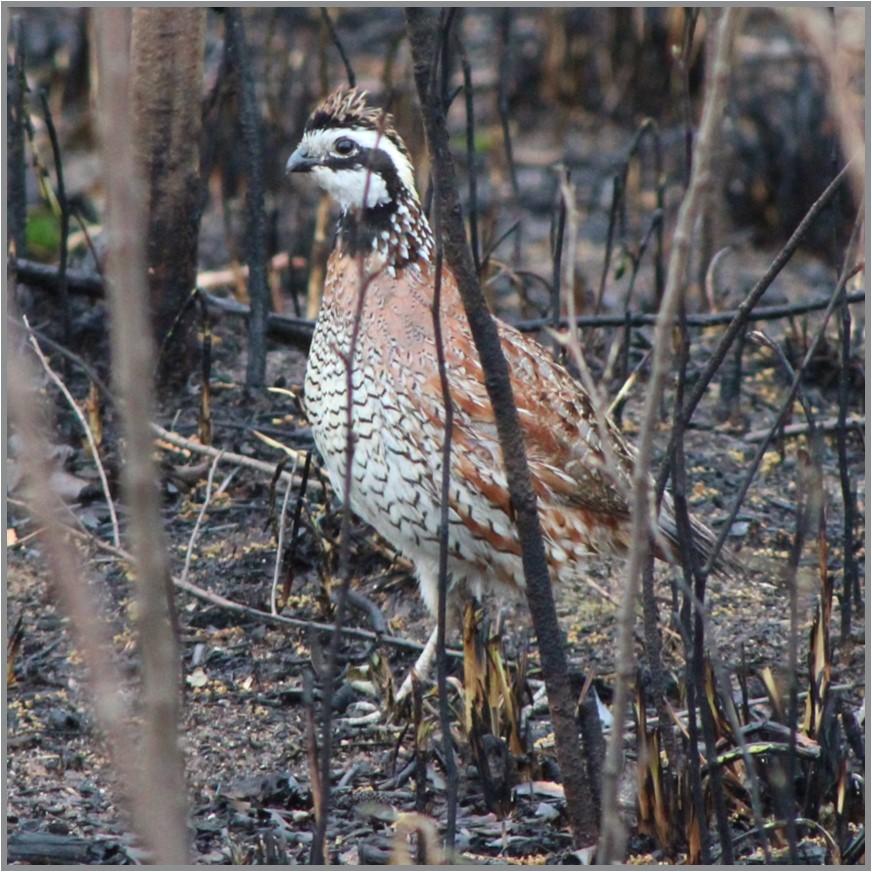
Populations of northern bobwhite (also known as bobwhite quail or quail) have experienced the largest declines of any bird in Maryland over the last 50 years (Fig. 1). Although that alone is an important reason to work for their conservation, northern bobwhite are considered an “umbrella” species, meaning that by creating and improving habitat for quail, many other species in their same ecological community will benefit (Crosby et al., 2015). In fact, the North American Breeding Bird Survey reveals that 83% of grassland birds and 57% of shrubland birds have experienced significant declines, highlighting the importance of this habitat type for a suite of birds, as well as for pollinators and other wildlife species.
Northern bobwhite require a specific type of habitat, known as “early successional” habitat. The term early successional comes from the concept of ecological succession, which is a natural process by which plant communities, when not disturbed, mature over time from open grassland and wildflower areas into shrublands, young forests, and finally mature forests (Fig. 2). Early successional habitats are those habitats found in the early years following a major disturbance, and include a diversity of habitat types such as wildflower fields, grasslands, meadows, shrublands, and young regenerating forests. Bobwhite quail require the following three habitat components in a 20–80-acre area to thrive:
- Diverse mix of “forbs” (broadleaf plants) and wildflowers,
- Interspersed native bunchgrasses for nesting, and
- Shrubby cover, for thermal cover during the winter and to escape from predators.
These habitat components allow for the production of food in the form of diverse weed seeds and vegetation (Masters et al., 2016), cover from predators and thermal protection in winter, the structure for nesting and reproduction, and the ability for bobwhites to move and forage across their environment.
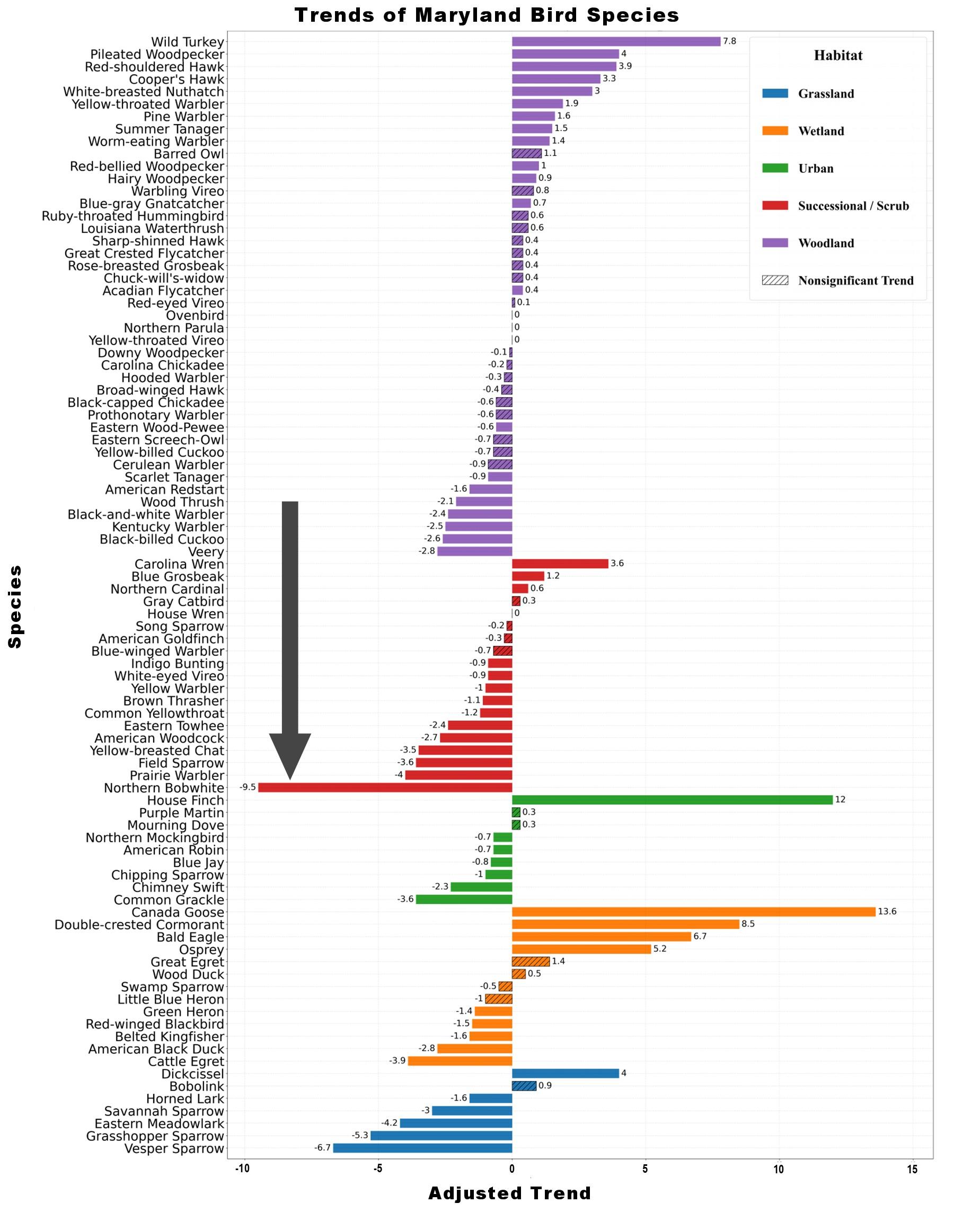
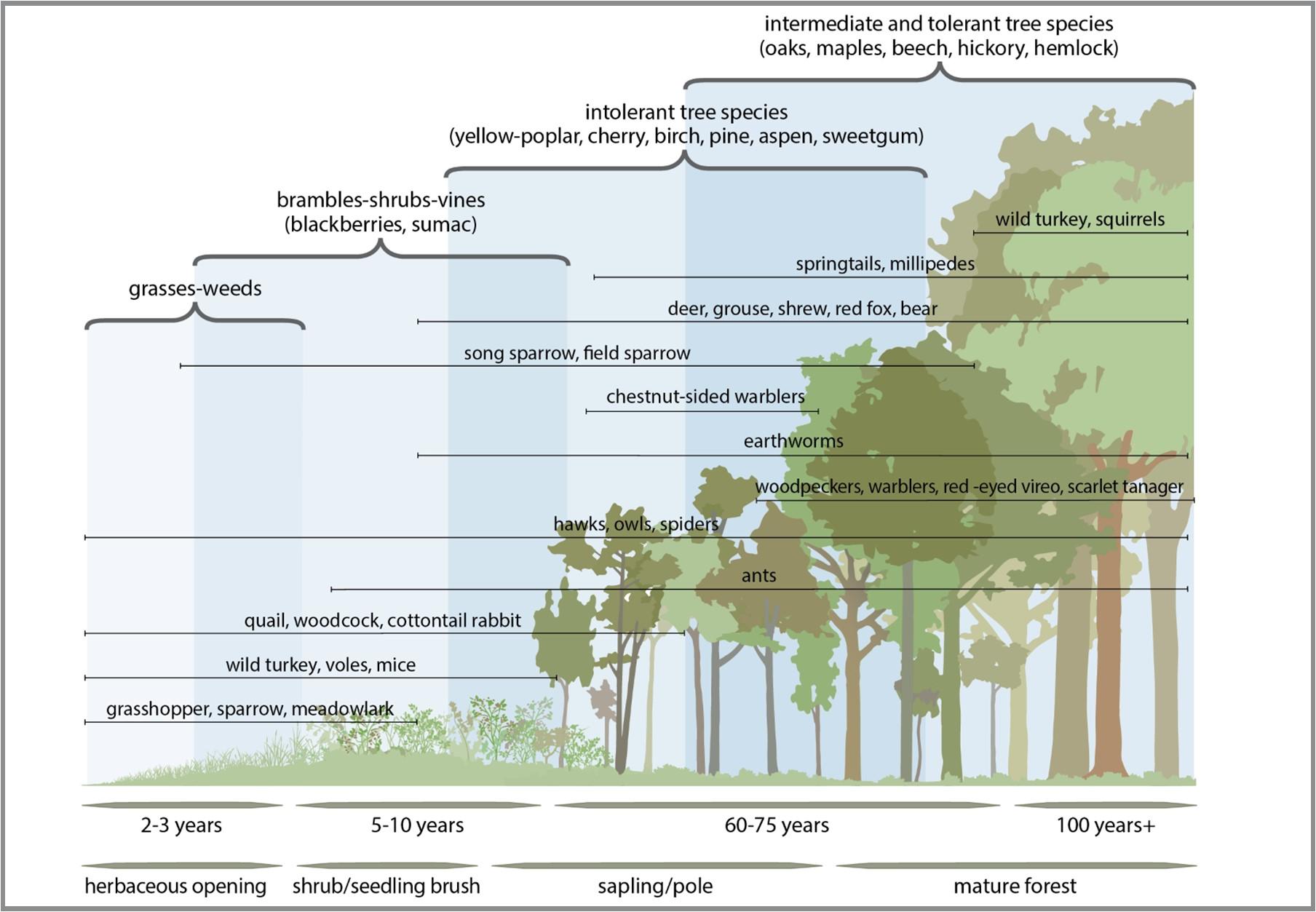
Why are Quail and Other Grassland Birds Disappearing?

Multiple factors have contributed to the decline of quail and other grassland birds, but most coalesce around the loss of native weedy and shrubby types of habitat on the landscape. Here are eleven contributing factors:
- “Hard” edges: Hard edge is the abrupt transition from open area to wooded area without transitional shrubby vegetation. Much of Maryland’s landscape is composed of agricultural fields adjacent to mature forests with minimal shrubby vegetation in between. This creates a “hard” edge between agriculture and forest without the ground-level herbaceous vegetation needed by bobwhites.
- Hay & pasture: Hayfields and pasturelands are oftentimes composed of non-native grasses that grow too thick and lack bare ground and forbs that quail need for movement. Furthermore, normal hay-cutting coincides with the nesting season of quail and many other ground-nesting birds, leading to 100% mortality of unfledged chicks (Perlut et al., 2006).
- Development: Developed land now covers more than 20% of Maryland’s land area. This, combined with the ongoing fragmentation of the natural landscape into urban and suburban areas, reduces habitat available for these birds.
- Herbicide-resistant cropping systems: Herbicide-resistant crops have dramatically improved weed control and agricultural productivity. However, the reduction of weedy vegetation in agricultural fields has diminished the value of agricultural fields as habitat for quail by reducing the forage, cover, and insect diversity that bobwhite need to survive.
- Changes in forest management & composition: The majority of Maryland forests are between 60-100 years old, and there is less forest harvest activity today, resulting in a lack of young regenerating woodlands that provide thick cover needed by bobwhite quail. (Fig. 3).
- Manicured lawns & removal of weedy vegetation: Landscaping preferences in both residential areas and rural areas have tended towards removing all brushy, weedy, and overgrown areas through regular mowing or bush-hogging. These overgrown weedy areas are the kind of habitat quail need to survive and breed.
- Reduction of small-scale livestock ownership & pasture: Reduction of small farm livestock ownership and its accompanying small weedy pastures has reduced habitat that would have been used by quail.
- Consolidation of agricultural fields: Agricultural fields that are consolidated into larger fields with fewer hedgerows and the lack of weedy and brushy edges reduce habitat on the landscape.
- Invasive species: Invasive species and planting of non-native sod-forming grasses like tall fescue have made many existing grassland areas inhospitable to quail.
- Increased predator populations: Bobwhites are well-adapted to escape predation with the right habitat in place, including thick shrubby and brushy areas. However, the reduction in quality quail habitat along with increasing predator populations has likely led to predation levels that can reduce bobwhite populations. Raccoons, opossums, hawks, foxes, and coyotes have increased in number due to the reduction in trapping and from food subsidies associated with human activities. A recent study found that control of mid-size mammalian predators can increase bobwhite reproduction rates (Palmer et al., 2019).
- Absence of fire, discing, and grazing disturbances: Most parts of the historic range of bobwhites experienced fire every 1-12 years prior to settlement (Guyette et al., 2012) as well as grazing by herbivores including bison and elk. Bobwhites are often described as the “fire bird,” due to their preference for habitats that are frequently burned. Dramatic reductions in fire and grazing herbivory on the landscape has reduced habitat for bobwhites.
Although the preceding list of factors contributing to the declining bobwhite population is long, landowners have been able to successfully reintroduce wild bobwhite populations in Maryland by creating the proper habitat and by releasing wild quail for several consecutive years. Populations have also increased in areas where habitat improvement efforts have taken place, such as at Nanticoke Wildlife Management Area. Given the extirpation of quail from large areas of the landscape, reintroduction efforts coupled with habitat practices would increase the speed of recovery for bobwhites.
The Solution: Habitat
Compared to most birds, northern bobwhite quail have relatively small home ranges. They require all their habitat needs in an area of between 20-80 acres (Covaleccio & Williams, 2010).
The Rule of Thirds: 3 core habitat components:
Each of these three habitat cover types can be represented in approximately equal measure (1/3 each) on the landscape to provide excellent habitat for quail.
- A diverse and patchy mix of forbs: brood rearing. These native wildflowers and other broadleaf plants provide seeds that quail eat. They also attract insects that provide protein for growing quail chicks’ diet in spring and summer. Finally, their structure usually provides a canopy over bare ground that protects quail from aerial predators and allows chicks to move at ground level. Beneficial plant species include common native weed species that arise from the seedbank or that can be planted (see example species list in Table 1).
- Dispersed native bunchgrasses: nesting habitat. Quail often build their nests at the base of native bunchgrasses. Preferred species include little bluegrass and broomsedge (the latter is common and often readily colonizes sites from the seedbank in Maryland). Grasses should not be too thick or dominate the site.
- Thick shrubby cover: predator escape and thermal protection. that provides escape from predators, areas to rest, and protection from major snow events. Brushy fencerows and hedgerows provide ideal cover. Common species include eastern red cedar, northern bayberry, high-tide bush, sapling trees, and brambles.
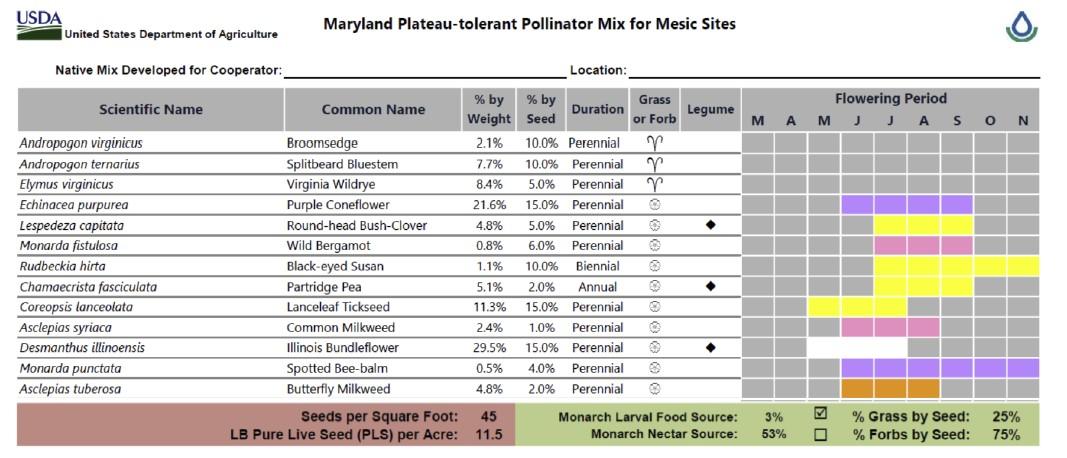
Grass Dominance: A Common Habitat Challenge
Not all grasslands are the same. In fact, quail generally prefer forb-dominated communities to grass-dominated ones. Many existing grasslands, whether they are buffers around farm fields or hay fields, have a high composition of non-native cool-season grasses or even native warm season grasses that are too thick to provide quality habitat for northern bobwhite. Tall fescue grass, a cool-season exotic species, is a common species seeded in grasslands for erosion control. However, it creates unfavorable habitat because of it creates a mat of vegetation and eliminates the bare ground access needed by quail and quail chicks to forage (Sinnott et al., 2022). Thick native grass stands can be equally problematic. Land managers can improve these areas as habitat for quail by diversifying the species composition of grasslands and encouraging broadleaf plants and wildflowers using the techniques discussed below.
Use of Insecticides
The use of insecticides will significantly reduce the value of a patch of habitat. Bobwhite chicks feed almost exclusively on protein-rich insects during their first few weeks of life and insecticides will remove this key ingredient for population growth.
How to Create Habitat
There are three main ways to create habitat for northern bobwhite:
- Fallowing agricultural land
- Forest management, including thinning and clearcuts
- Planting native seed mixes
1. Fallowing
Fallowing agricultural fields can be one of the easiest and least expensive ways to create bobwhite habitat. Many native forb and grass species readily sprout from the seedbank, even in agricultural fields that have been plowed or sprayed with herbicides for many years. Birds, terrestrial animals, and wind disperse native seed from nearby areas facilitating rapid recolonization. Invasive species can be a concern that can be mitigated through a variety of techniques including herbicides and strategically timed mowing to prevent undesirable plants from going to seed.
Oftentimes in the first year following fallowing, annual grasses can dominate an area, but over time, these species will often decrease in dominance as more desirable wildflowers and other forbs colonize the site. If thick non-native annual grasses continue to dominate a site, the use of grass-selective herbicides (e.g. clethodim) can greatly reduce those species to give forbs a competitive advantage. Selective herbicides such as imazapic will kill cool-season grasses and allow many forbs and native grasses to survive (not all native species are tolerant, so read the label carefully). Additionally, many exotic cool-season grasses can be controlled with broad spectrum herbicides timed in the fall after desirable species have gone dormant and set seed. In Maryland, this can be done safely from November to March. Note that herbicides often work slower in cooler temperatures, or may become ineffective in freezing weather, so always consult the herbicide label for recommendations given weather conditions.
2. Forest Management
2.1 Thinning
Significantly thinned forests that create a more open habitat can provide quality habitat for northern bobwhite in addition to many other bird species. Trees should be thinned to an extent that sufficient sunlight reaches the ground to stimulate herbaceous plant growth at the ground level. Generally, forests of less than 40 square feet of basal area per acre are sufficiently thinned to support bobwhite quail (Elledge & Barlow, 2018). Another measure of appropriately thinned forests is to have 65 feet from the canopy edge of one tree to the canopy edge of the next. To maintain long-term habitat, prescribed fire, grazing, or ongoing forest management practices will be needed to maintain the grass/herbaceous understory.
2.2 Clear-cuts
The term clear-cut often has negative connotations, but properly planned and implemented clearcuts can mimic the natural disturbances that would have created quality bobwhite habitat. Prior to European settlement, disturbances ranging from fire to herbivory by large grazers like elk and bison would have helped maintain early successional or savannah type of habitat. Clear-cuts allow sunlight to reach the forest floor; in most places, within 1-2 years of the cut, herbaceous vegetation at ground level recovers and provides a habitat type that is generally lacking on the Maryland landscape – grasslands, shrublands, and young forests. This early successional habitat can provide quality wildlife habitat, especially for many declining bird species like bobwhites that require areas of thick vegetation close to ground level.
2.3 Forest Management Plan
A first step to managing a forest for northern bobwhite quail habitat is to develop a forest management plan for your property by working with the Maryland Forest Service or a licensed professional forester. This management plan qualifies landowners for cost-share assistance for wildlife habitat improvement work through the Maryland Wildlife Incentive Program (WIP) as well as federal cost-share assistance through the Environment Quality Incentive Program (EQIP). Be sure to include bobwhite quail habitat as one of your objectives in your forest management plan so the forester can develop an appropriate document.
3. Planting
Although the seedbank will oftentimes sprout sufficient native plants for wildlife habitat, planting fields with native seeds can help accelerate new habitat growth and increase the diversity of species present. The increased diversity of pollinator plants attracts insects needed for bobwhites, especially while they are rearing chicks. Planting native mixes can be implemented through broadcast seeding, no-till drilling with a special native seed box, and with or without disking. Herbicide application prior to planting reduces non-native weed competition and helps to increase establishment success. Organic approaches often involve planting a cover crop that develops a mulch that helps smother out weed competition in the year prior to planting the native seed.
3.1 Seed mixes
Seed mixes should include a diverse mix of species to achieve the structural characteristics that will benefit northern bobwhite. In particular, seed mixes should contain a majority of forbs and wildflowers that attract insects, and provide seed, while leaving bare ground beneath the canopy for movement of birds.
Ideally, seed should be acquired from local native seed sources. Your local Natural Resource Conservation Service office can help develop seed mixes, refer you to local suppliers, and may be able to provide financial support for seeding native habitat (see Table 1 for example species).
3.2 Broadcast, Drop-seeder, or Drill Seeding
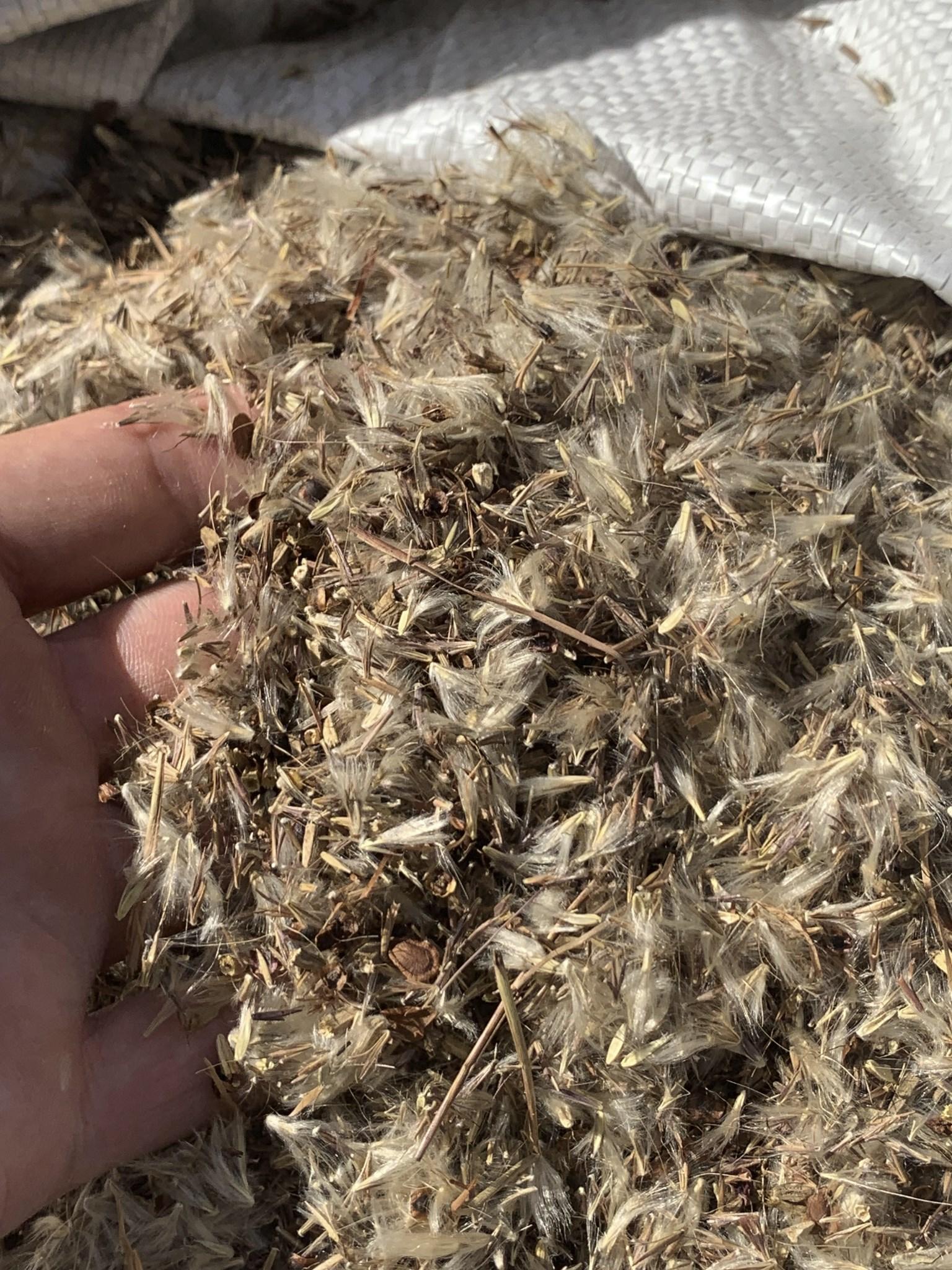
Native wildflower and grass seed mixes can be successfully planted using broadcast, drop-seeding, or using a native seed drill. Each has advantages and disadvantages given the circumstances of the site. Each of these can be used in either a tilled/disked soil bed or in a no-till system with advantages or disadvantages based on weed pressure, time of year, mulch present, and other factors.
Each approach can vary in success due to differences between the native seed mix germination characteristics. For example, some seeds germinate better while on the soil surface and exposed to “scarification” (the softening of the seed coat through weathering) and “stratification” (periods of cold and moist conditions needed to break dormancy) processes of the weather. Other species germinate better below ground. Successful seed germination can also vary depending on differences in soil types, temperature, soil moisture, predation pressure (by birds or small mammals), weed competition, and other factors.
During the first year after seeding, planted species often only represent 15-25% of the cover in an area. However, these percentages usually increase substantially in subsequent years as perennial species become more vigorous and produce their own seed. In general, managers of larger acreages (greater than 5 acres) use a native seed drill or drop-seeder. This method can plant greater acreages than broadcast seeders, which need to be refilled more frequently due to the added bulk of carriers (see below).
Harper et al. (2007) includes more in-depth discussion on seeding approaches.
3.2a Broadcast considerations:
Native seed mixes often include fluffy wildflower and native grass seeds (fig. 4). A carrier such as vermiculite helps distribute the seeds more evenly. Harper et al. (2007) recommends increased seeding rates by 50-100% when broadcast seeding native grass and forb mixes to compensate for seeds that germinate then dry out and die on the soil surface. However, in an ongoing study at the University of Maryland’s Wye Research & Education Center, broadcasting a forb-dominated mix into a disked seedbed yielded better establishment than a drilled treatment without a need for increased seeding rates. The differences in success rates are likely heavily influenced by 1) different seed mixes and 2) weather conditions in the early weeks of germination.
In addition, the ongoing research at University of Maryland found that broadcasting seed at a doubled seeding rate into an unprepared field of harvested corn yielded a good establishment rate in the first year and included a greater presence of two planted forb species that were rare in disked and drilled plots: wild bergamot and common milkweed. As noted above, this illustrates how individual seeds respond differently to planting conditions. It also shows that native plants can be established without the use of disking equipment if planting into a field coming out of crop production with weed control.
3.2b Drop-seeding with native seed drill:
Drop seeding is a seeding approach similar to broadcasting in that the seeds are dropped on the soil surface and the cutting wheels of the drill do not open the soil surface. Drop-seeding is usually conducted on a tilled or disked seedbed and followed by culti-packing to enhance seed-to-soil contact and to improve seed germination rates.
3.2c Native seed drill considerations:
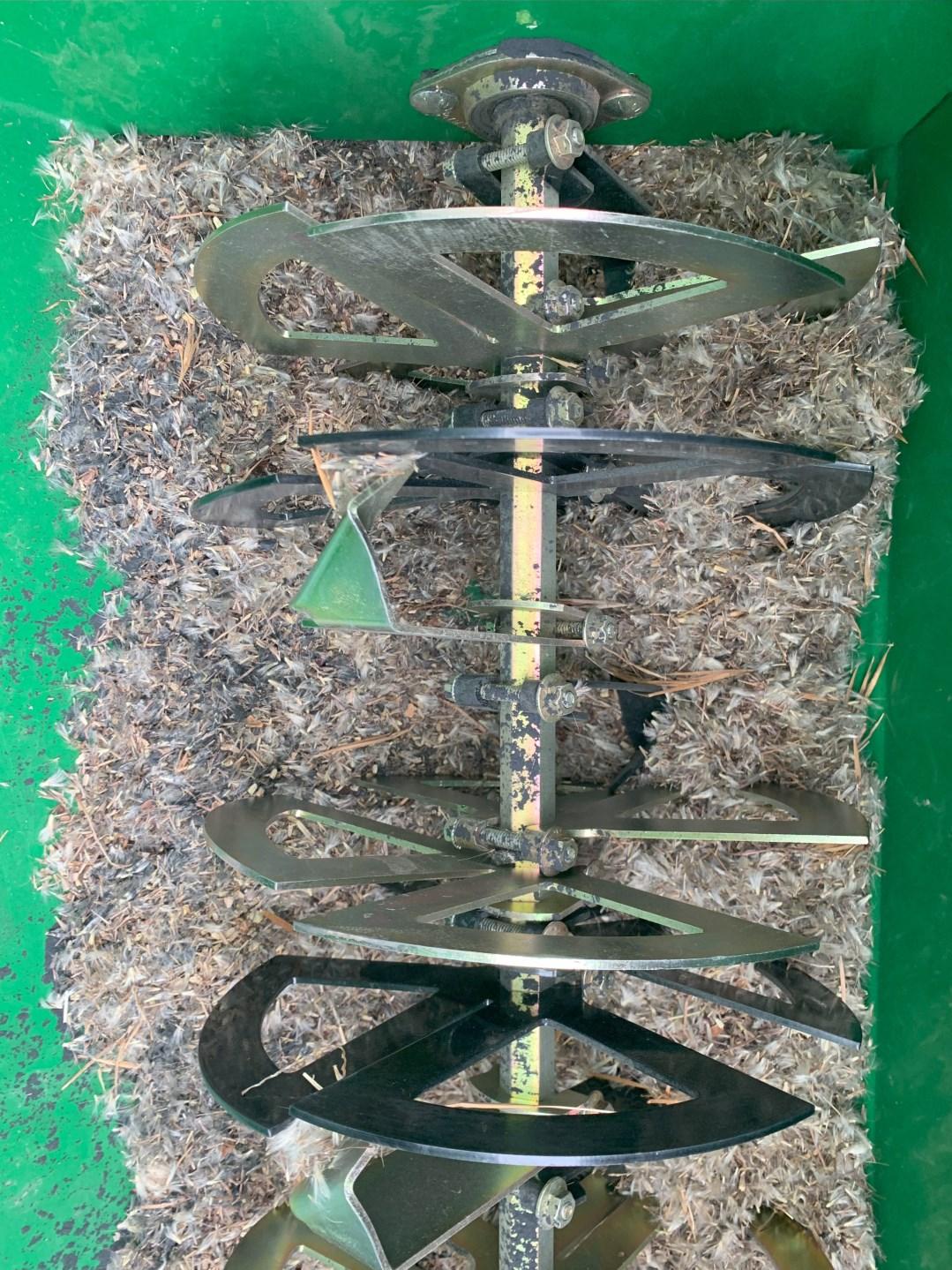
Native seed drills differ from conventional no-till planters in that they include an agitator arm that slowly moves the seed in the seeding container to facilitate movement of the seed down the planting tubes (fig. 5). For native seed drills, managers should check the drill’s tubes during planting to ensure clogging does not occur. The drill depth should be calibrated to ensure seed are not drilled more than ¼” deep. It is better to plant too shallow than too deep. A good way to check this is to make sure you are able to see some native seed remaining on the soil surface after planting.
3.3 Disked vs No-Till
Researchers have found mixed results in the most effective planting method for wildflower and native grass mixes. One study reported better establishment with tillage (Ghajar et al., 2022), while another found improved results using no-till approaches (Angelella and others, 2019). University of Maryland researchers at the Wye Research & Education Center found enhanced establishment cover in the first year after planting in disked sites that were broadcast seeded. If planting into a field coming out of crop production, seed may be broadcast on the soil surface with a handheld broadcast spreader, ideally before March. As noted above (Section 3.2a), research at the Wye found acceptable establishment rates by broadcasting in a field of corn stubble at a doubled seeding rate. Drilled treatments had the lowest establishment rate. Most of the differences between these different methods became less apparent in the second year, after plants became established and came to represent between 25-50% of plant cover on the site.
3.3a Disking
A rotational disking program is perhaps the easiest way to set back vegetation growth and promote forb cover and bare ground for quail. The resulting habitat is ideal for foraging bobwhite chicks and is often referred to as “brood-rearing” habitat. Having designated areas (~20% of manageable land) annually disked for brood-rearing habitat can significantly improve chick survival. Disking in winter promotes greater forb establishment the following spring, while disking in spring generally encourages less desirable annual grass establishment. Managers can perform disking on a 1–5-year rotation system, where different sections of a grassland are disked each year. This allows for a diversity of plant structures in a small area and also leaves sufficient non-disked area with vegetation cover for birds over winter.
3.3b No-Till
No-till methods that do not disturb the soil help to maintain many soil health characteristics and provide benefits by reducing the flush of annual grasses that is usually accompanied by disking (especially if disked in March or April). Proper calibration of the drilling depth and the seeding rate is essential to good stand establishment in a no-till environment. If set too shallow, the drill cutters may not break through mulch on the soil surface (such as corn stalks, cover crops, or other litter). If calibrated too deep, seeds can be buried too deep and not be able to emerge from the soil.
3.3c Timing
Native seed mixes can be sown from December through early May. Many studies have found that earlier seeding times allows many seeds to undergo the processes of scarification and stratification. These processes can enhance seed-to-soil contact, germination, and enhanced establishment of wildflowers and forbs. Additionally, when seeded earlier, germination can occur when temperature and moisture conditions are ideal for the particular seed and can give the seedlings a head start in the growing season when weed competition arises.
How to Maintain or Improve Habitat
There are two common challenges associated with maintaining and improving existing habitat:
- The dominance of grasses, especially cool-season exotic grasses like fescue that forms a sod and reduces the bare ground needed by bobwhites, and especially bobwhite chicks, to move on the ground, and
- The encroachment of woody vegetation that eventually results in the open grassland becoming a young forest.
The following six sections provide managers with options for enhancing bobwhite habitat.
Herbicides
To control undesirable herbaceous plants:
Herbicides are an important tool in reducing grass dominance in many existing grasslands. Herbicides can be used in three main ways:
- To control cool-season grasses, broad-spectrum herbicides such as glyphosate or grass-specific clethodim in November to March when native grasses and forbs are dormant, but when cool season grasses are still green and growing (periods of warmer weather in November are a good time in many parts of Maryland);
- Using selective herbicides like imazapic (brand name Plateau) during the growing season that will kill many of the non-native grasses, but that will allow many of the native warm season grasses and forbs to survive. Imazapic can kill some native species, so read the label to note which species are tolerant and intolerant of specific herbicide rates; and
- To control warm-season grasses, managers can apply strips of a grass-selective herbicide (such as clethodim) during the growing season to reduce both warm-season and cool-season grass cover in an area where they have become too dominant.
To control undesirable woody tree species:
Herbicides can also be effective in preventing woody encroachment and the conversion of a grassland or meadow into a woodland. Common woody species include sweetgum and Callery pear, which can be controlled using formulations of triclopyr or glyphosate in foliar applications, with hack & squirt / drill & squirt techniques, or through basal bark treatment (spraying the bark around the entire circumference of the tree). Always read and follow the label and directions of use of any herbicide.
Disking
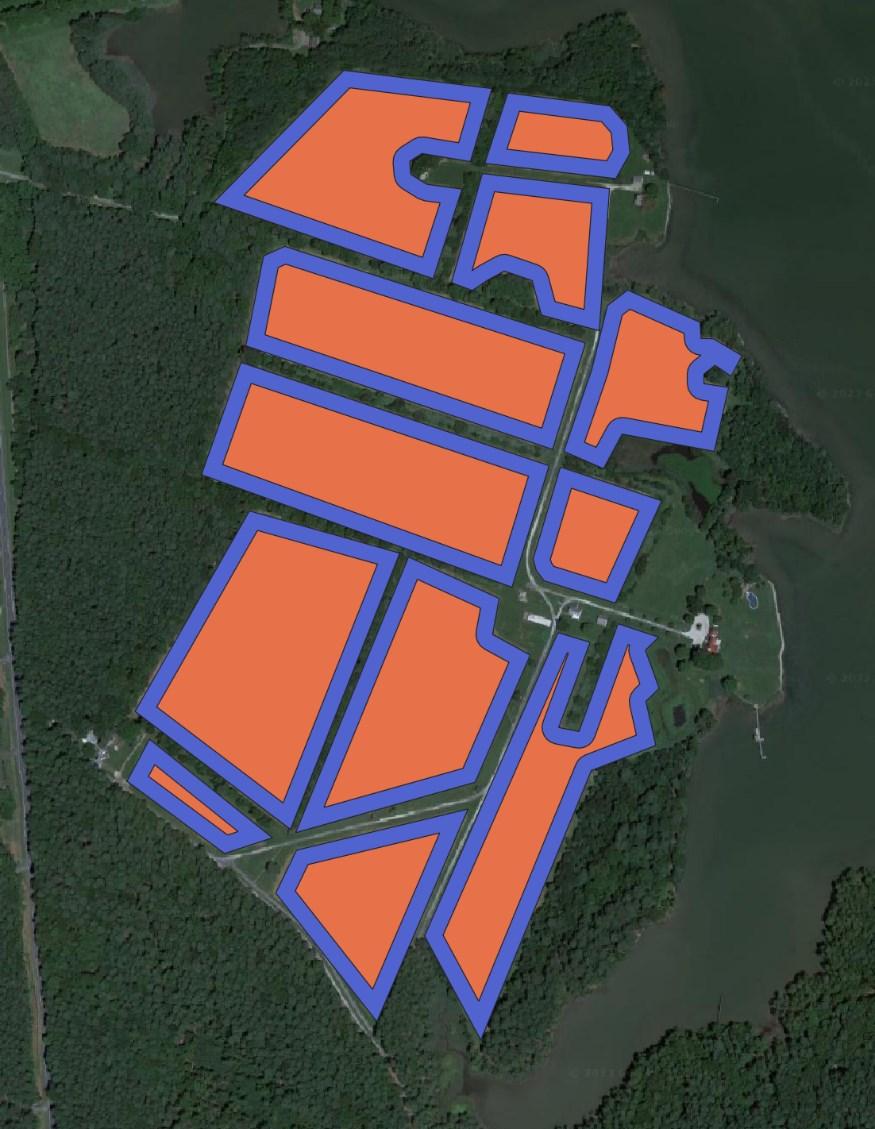
A rotational disking program is perhaps the easiest way to set back vegetation growth and promote forb cover and bare ground for quail. The resulting habitat is ideal for foraging bobwhite chicks and is often referred to as “brood-rearing” habitat. Having designated areas (~20% of manageable land) annually disked for brood-rearing habitat can significantly improve chick survival. Disking in winter promotes greater forb establishment the following spring, while disking in spring generally encourages less desirable annual grass establishment. Managers can perform disking on a 1–5-year rotation system, where different sections of a grassland are disked each year. This allows for a diversity of plant structures in a small area and also leaves sufficient non-disked area with vegetation cover for birds over winter.
Another approach is to use disking to create both fire-breaks and brood-rearing habitat by creating rings around core areas that are burned in March and April on a rotation of every 2-3 years (fig.6).
Mowing
Mowing between April 15 and August 1 will destroy quail nests and negatively impact populations. As such, mowing is generally not a recommended practice except in certain circumstances. In general, winter disking is preferred to mowing as it helps stimulate forb production and facilitates bare ground, which is essential for quail movement. Mowing in fall removes important winter cover needed by birds to survive cold spells and snowfall events. Because bobwhite chicks nest inside warm season bunchgrasses, mowing in summer can destroy nests and cause direct mortality of young chicks.
However, mowing can be used in a few circumstances at certain times of year:
- Mowing (oftentimes at levels of 8"-10”) can be used to reduce competition and seed production of non-native species in mid-to-late summer. This is often performed after July 15 to reduce impacts to nesting.
- Mowing can reduce thick vegetation and set back sapling trees, although with dense stands of native warm season grasses, it can sometimes increase the thickness of vegetation to the detriment of habitat for quail. If disking, herbicides, grazing, and prescribed fire are not available management options, mowing can be performed in early spring, between March 15and April 15. This timing allows new vegetation to quickly grow up to provide cover for bobwhites.Over time, sapling trees will often resprout and develop large root bases becoming more challenging to control in the future, making herbicide or disking more effective approaches for controlling woody saplings.
- Mowing a path through a meadow can provide access for walking and observing wildlife and create structural diversity in a meadow that can benefit various wildlife.
If mowing is the only option for managing vegetation, the negative impacts can be reduced by only mowing one-third to one-half the area to leave cover for birds. To avoid mortality of quail nests, do not mow between April 15 to July 15 (or later) when bobwhites and other ground-nesting birds are actively nesting in fields.
Grazing
Livestock grazing naturally creates structural diversity crucial for bobwhite habitat (Hodges et al., 2021). Cattle selectively graze on palatable plants, oftentimes preferring grasses over broadleaf plants, which can help with reducing grass dominance noted above. This grazing selectivity leaves some plants minimally grazed and creates a varied vegetation structure and areas of bare ground for quail movement. This process can be managed through stocking rate, duration, and redistribution of grazing with the use of fencing, water, shade, and mineral placement. Given appropriate infrastructure of water and fencing, grazing can result in fine-scale habitat heterogeneity that could be more time- and resource-efficient than other tools noted in this section.
Prescribed fire
Famed quail biologist Herbert L. Stoddard nicknamed northern bobwhites the “fire bird,” owing to its positive response to landscapes that are frequently burned. Prescribed burning has a variety of effects on the ecology of an area. In particular, it removes thatch from the soil surface revealing bare ground, allowing sunlight to reach the soil and facilitating germination and new plant growth. It produces chemical changes in the soil that can be advantageous for certain plants. Perhaps of most practical use to land managers is that it can help to set back the growth of saplings and young trees that can quickly take over grassland habitats and shade out many wildflowers and shrubs that provide food and cover needed by bobwhites.
Fire is effective at killing eastern red cedar if it becomes too dominant (although it’s usually a beneficial source of evergreen winter cover in many parts of Maryland), and can set back the growth of other woody trees like oaks and sweetgums. In Maryland, managers planning prescribed fires greater than one acre are required to have a written prescribed burn plan through the Maryland Forest Service, and those burns must be conducted and supervised by a qualified and experienced Burn Boss. The DNR Forest Service, at its discretion, may approve burns that are less than one acre based on a verbal plan and will issue the required burning permit.
Most prescribed fires for quail habitat are conducted between March 1 and April 15 to reduce impacts on nesting birds. A general rule of thumb is to maintain a 2-year fire return interval, burning approximately 50% of manageable habitat. Imagine a checkerboard: the white squares might be burned this year, while the black squares are burned the next. Consistency is key. Late summer or fall burns (after August 15) can also be a tool for more effectively reducing woody vegetation than spring burns but should be conducted to ensure sufficient winter cover remains in an area for bobwhite to survive a potentially harsh winter.
Wildlife-friendly Hayfields
Hayfields are often used by a variety of ground-nesting birds including northern bobwhites. Conventionally managed hayfields have two main limitations as habitat for bobwhite quail: 1) They are usually composed of too great a percentage of grass, especially non-native cool season grasses. While these may be beneficial for birds such as meadowlarks and grasshopper sparrows (Moorman et al., 2017), they are not good habitat for bobwhite. 2) Hay cutting during the nesting season leads to nearly 100% mortality of chicks on nests. To addressthese challenges and improve hayfields to serve as habitat for ground-nesting birds, landowners and land managers make hay-farming more wildlife friendly by using the following guidelines:
- Delay cutting hay fields until July 15 if possible, or at least to July 1.
- Let fields rest 50-60 days after cut to allow for a full nesting cycle to complete.
- Diversify hay-field species composition to a more diverse mix of broadleaf plants and a lower proportion of exotic grasses.
Conclusion:
Recent improvements in bobwhite abundance and recolonization of sites following habitat improvement work in Maryland and elsewhere show that land management efforts can reverse the decline of the northern bobwhite quail. This publication summarizes some of the key approaches for creating and maintaining early successional habitats, that include a diverse mix of forbs, native bunchgrasses, bare ground, and shrubby cover. Management practices such as fallowing agricultural land, forest management with 65-foot spacing between tree canopies, and planting native seed mixes can create and improve habitat, while prescribed fire, disking, herbicides, and grazing are key of the tools to maintain the habitat in a state where bobwhites can thrive. These proactive practices will not only help to reverse the decline in bobwhite populations, but will also improve the broader ecosystem, especially for other grassland and shrubland bird species such as the grasshopper sparrow, prairie warbler, and eastern meadowlark that are in significant decline.
References:
- Aldrich, J. H. (2002). Establishment of modest-sized wildflower plantings. Native Plants Journal, 3, 17.
- Angelella, G. M., Stange, L., Scoggins, H. L., & O’Rourke, M. E. (2019). Pollinator refuge establishment and conservation value: impacts of seedbed preparations, seed mixtures, and herbicides. HortScience, 54, 445–451.
- Colavecchio, A., & Williams, C. (2010). The Northern Bobwhite of the Mid-Atlantic: A Landowners Guide to their Ecology and Management. University of Delaware, College of Agriculture & Natural Resources, Cooperative Extension.
- Crosby, A. D., R. D. Elmore, D. M. Leslie Jr., R. E. Will. 2015. Looking beyond rare species as umbrella species: northern bobwhites (Colinus virginianus) and conservation of grassland and shrubland birds. Biological Conservation 186: 233-240
- Elledge, J., & Barlow, B. (2018, October 17). Basal Area: A Measure Made for Management. Alabama Cooperative Extension System. Retrieved from https://www.aces.edu/blog/topics/forestry/basal-area-a-measure-made-for-management/.
- Frost, J. B. (2000). An evaluation of short-term mesomammal control to improve nesting success and survival of northern bobwhites in west central Texas. Angelo State University.
- Ghajar, S. M., Wagner, J. F., O’Rourke, M., & Tracy, B. F. (2022). Evaluating methods to establish biodiverse pasturelands with native grasses and wildflowers. Native Plants Journal, 23(1), 65-74.
- Harper, C. A., Bates, G. E., Hansbrough, M. P., Gudlin, M. J., Gruchy, J. P., & Keyser, P. D. (2007). Native warm-season grasses: Identification, establishment, and management for wildlife and forage production in the Mid-South. UT Extension, PB 1752. Knoxville, TN.
- Hodges, J. L., Keyser, P. D., Newman, W., Brazil, K. A., DeMaso, S., & Diener, R. (2021). Beef, Grass, and Bobwhites - Quail Management in Eastern Native Warm-Season Grass Pastures. National Bobwhite Technical Committee.
- Holechek, J. L., Valdez, R., Schemnitz, S. D., Pieper, R. D., & Davis, C. A. (1982). Manipulation of Grazing to Improve or Maintain Wildlife Habitat. Wildlife Society Bulletin, 10(3), 204–210. Retrieved from http://www.jstor.org/stable/3781006
- Masters, R. E., Montague, W. G., & Cram, D. S. (2016). Northern bobwhite autumn and winter food habits in restored pine–bluestem habitats. Wildlife Society Bulletin, 40, 300-309. https://doi.org/10.1002/wsb.646
- Moorman, C. E., Klimstra, R. L., Harper, C. A., Marcus, J. F., & Sorenson, C. E. (2017). Breeding songbird use of native warm‐season and non‐native cool‐season grass forage fields. Wildlife Society Bulletin, 41(1), 42-48.
- Palmer, W. E., Carroll, J. P., Sisson, D. C., Wellendorf, S. D., Terhune, T. M., Ellis-Felege, S. N., & Martin, J. A. (2019). Reduction in Meso-Mammal Nest Predators Improves Northern Bobwhite Demographics. The Journal of Wildlife Management, 83(3), 646–656. https://www.jstor.org/stable/26695333
- Perlut, N. G., Strong, A. M., Donovan, T. M., & Buckley, N. J. (2006). Grassland songbirds in a dynamic management landscape: Behavioral responses and management strategies. Ecological Applications, 16, 2235-2247. https://doi.org/10.1890/1051-0761(2006)016[2235:GSIADM]2.0.CO;2
- Sinnott, E. A., Thompson, F. R., Weegman, M. D., Thompson, T. R. (2022). Northern Bobwhite juvenile survival is greater in native grasslands managed with fire and grazing and lower in non-native field borders and strip crop fields. Ornithological Applications, 124(1), duab057. https://doi.org/10.1093/ornithapp/duab057
- Skousen, J. G., & Venable, C. L. (2008). Establishing native plants on newly constructed and older-reclaimed sites along West Virginia highways. Land Degradation & Development, 19, 388–396.
- Staller, E. L., Palmer, W. E., Carroll, J. P., Thornton, R. P., & Sisson, D. C. (2005). Identifying Predators at Northern Bobwhite Nests. The Journal of Wildlife Management, 69(1), 124–132. Retrieved from http://www.jstor.org/stable/3803591
Additional resources:
- "Conservation Cover (327) for Upland Birds" by the USDA Natural Resources Conservation Service (NRCS) https://nrcspad.sc.egov.usda.gov/DistributionCenter/ pdf.aspx?productID=430
- "Volume 7, Issue 1 (2016) - Northern Bobwhite Symposium" by the University of Tennessee Libraries, TRACE: Tennessee Research and Creative Exchange https:// trace.tennessee.edu/nqsp/vol7/iss1/70/
- "Effects of Conservation Practices on Bobwhite and Other Grassland Birds" by the University of Tennessee Libraries, TRACE: Tennessee Research and Creative Exchange https://trace.tennessee.edu/cgi/viewcontent.cgi? article=1397&context=nqsp
- "Northern Bobwhite Quail - Landowner's Guide" by the Michigan Department of Natural Resources https://www2.dnr.state.mi.us/publications/pdfs/ huntingwildlifehabitat/landowners_guide/species_mgmt/quail.htm
- "Open Forest Management and Early Successional Habitats" by the U.S. Forest Service https://www.fs.usda.gov/rm/pubs_journals/2019/ rmrs_2019_hanberry_b001.pdf
- "Nonnative Grasses Negatively Impact Northern Bobwhite Use of Managed Conservation Reserve Program Fields" by the Journal of Wildlife Management, Wiley Online Library https://wildlife.onlinelibrary.wiley.com/doi/abs/10.1002/ jwmg.305
- "Bobwhite Quail Management in Oklahoma - OSU Extension Facts" by Oklahoma State University, Division of Agricultural Sciences and Natural Resources https:// shareok.org/bitstream/handle/11244/333939/oksa_E-0904_2014-08.pdf?sequence=1
LUKE MACAULAY
lukemac@umd.edu
This publication, Recovering Northern Bobwhite Quail: A Guide to Habitat Management (FS-2023-0683), is a part of a collection produced by the University of Maryland Extension within the College of Agriculture and Natural Resources.
The information presented has met UME peer-review standards, including internal and external technical review. For help accessing this or any UME publication contact: itaccessibility@umd.edu
For more information on this and other topics, visit the University of Maryland Extension website at extension.umd.edu
University programs, activities, and facilities are available to all without regard to race, color, sex, gender identity or expression, sexual orientation, marital status, age, national origin, political affiliation, physical or mental disability, religion, protected veteran status, genetic information, personal appearance, or any other legally protected class.
When citing this publication, please use the suggested format below:
Macaulay, L., (2024). Recovering Northern Bobwhite Quail: A Guide to Habitat Management (FS-2023-0683). University of Maryland Extension. go.umd.edu/FS-2023-0683